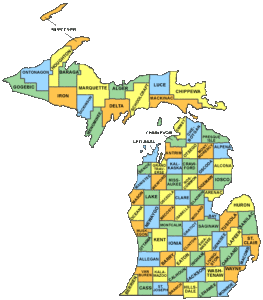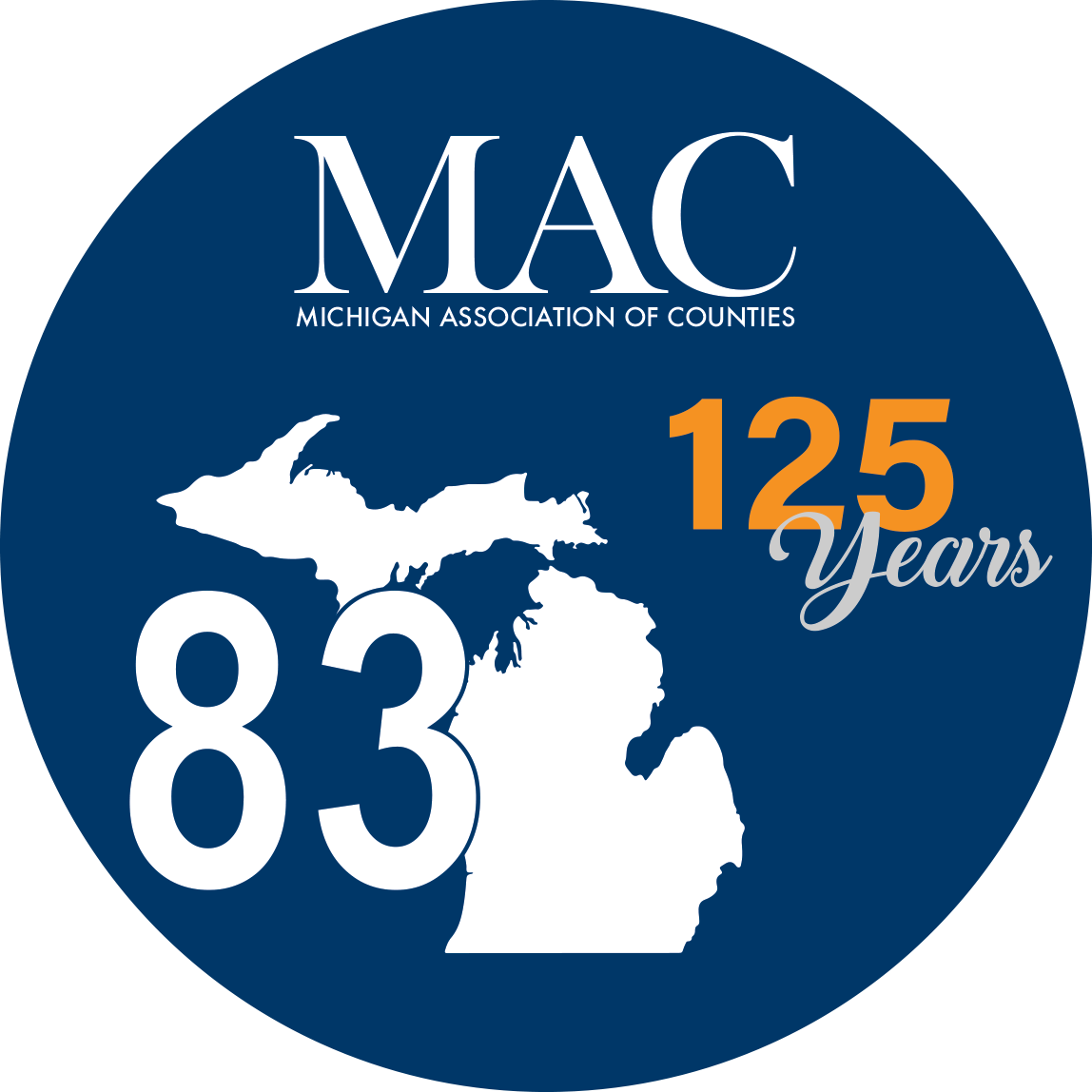Legislative Update 9-24-21
County revenue sharing increase highlights FY22 budget
 Lawmakers and the governor reached a deal on the FY22 budget this week, just days before the Oct. 1 start of the fiscal year. The budget allocates $10.4 billion in General Fund dollars.
Lawmakers and the governor reached a deal on the FY22 budget this week, just days before the Oct. 1 start of the fiscal year. The budget allocates $10.4 billion in General Fund dollars.
The budget includes a 2 percent increase in the base for county revenue sharing, but retained the language requiring the increase in revenue sharing in counties that have been deemed to be in an underfunded status with their pension system to go toward those pension obligations.
Other items of note include:
- $148.9M in Michigan Indigent Defense Commission Grants, which includes implementation of standard 5
- $14.5M for PFAS Remediation Grants
- $13M to fund a Dam Safety Grant Program, with an additional $6M for the Emergency Dam Safety Action Fund
- $14.3M in High Water Infrastructure Grants
- $16M in a one-time appropriation to the state 911 fund for NextGen Infrastructure
- This appropriation allows the Legislature to eliminate a fee increase in House Bill 5026 for postpaid phones and reduce the fee increase for prepaid
- $29.1M to the Raise the Age Fund, which is to cover cost outside of Child Care Fund eligible expenses for 17-year-olds
- EMS Medicaid fee schedule would be set at 100 percent of Medicare, which is an increase of $54.3M
- $51.4M for essential local public health services, with strings attached depending on local health orders: “If a local health officer has an emergency order under section 2453 of the public health code, 1978 PA 368, MCL 333.2453, in effect as of October 1, 2021, the funds appropriated in part 1 for essential local public health services are unappropriated. This subsection does not apply if a county board of commissioners passes a nonbinding resolution by a record roll call vote to support any emergency orders the local health officer has in effect on October 1 of the current fiscal year.”
According to news sources, “Language in the budget that would strip local health departments of their state funding if they have an emergency health order in place to protect against COVID-19 without the assent of their county board of commissioners will likely be deemed unenforceable by Governor Gretchen Whitmer.” MAC expects more legal information to be released soon.
In other county-related details:
- $5.2B transportation budget includes an additional $52.8M for local road agencies for a total to local road agencies of $1.8B.
- $414.5M gross ($146.1M GF) for a $2.35 per hour direct care worker wage increase.
- $26.5M gross, ($5M GF) (6 FTEs) to support a two-year implementation for the Certified Community Behavioral Health Clinic (CCBHC) Demonstration program
- $5.1M for the second year of a five-year phase-out of the use of Local CMH Local Match funding to support the Medicaid Restricted Mental Health Services line
- $4.25M to the county veteran service fund, $200,000 of which can be used by the Michigan Veteran Affairs Agency to fund administration and technical assistance to counties
- $2M in one-time money for the secondary road patrol grant program is to compensate for lost revenue due to the COVID-19 pandemic, bringing total support to the program at $15M
- $14.8M in the county jail reimbursement program, and agreement to remove language that bars reimbursement for any county that enacts or enforces any law or ordinance concerning the immigration status of an individual
- $2M for local conservation district operational support with an additional $1M one-time funding for FY22
- $45M in Federal funds for Water Infrastructure Improvement Grants for the City of Flint
- $2.1M increase to fully fund PILT payments
- $3M increase for the Michigan Infrastructure Council
Of the $6.5 billion in American Rescue Plan funds allocated to the state of Michigan, the FY22 budget and supplemental for FY21 utilizes just more than $770 million, including $150 million for the Unemployment Trust Fund. The remaining $5.76 billion will be allocated through a series of supplemental budget bills expected to begin negotiations this fall.
For more information about the budget, please contact Deena Bosworth at bosworth@micounties.org or Meghann Keit-Corrion at Keit@micounties.org.
U.S. Treasury provides guidance on Capital Projects Fund
 This week, U.S. Treasury released new guidance for the $10 billion Capital Projects Fund that was authorized under the American Rescue Plan (ARP). It is important to note that these are grants for states, which can then be awarded to subrecipients (i.e., counties).
This week, U.S. Treasury released new guidance for the $10 billion Capital Projects Fund that was authorized under the American Rescue Plan (ARP). It is important to note that these are grants for states, which can then be awarded to subrecipients (i.e., counties).
Key points from the guidance include:
- Provides $10 billion to U.S. Treasury to provide payments to states, territories, freely associated states and tribal governments to carry out critical capital projects directly enabling work, education and health monitoring, including remote options, in response to the public health emergency with respect to COVID-19
- All funds must be spent by Dec. 31, 2026. Recipients must return to Treasury any grant funds that are not used by the end of the period of performance on Dec. 31, 2026 (Treasury has the authority to provide grant extensions to the period of performance if a recipient requests one).
- For a Capital Project to be an eligible use of funds, it must meet all of the following three criteria (additional information on eligible projects below):
-
- The Capital Project invests in capital assets designed to directly enable work, education, and health monitoring
- The Capital Project is designed to address a critical need that resulted from or was made apparent or exacerbated by the COVID-19 public health emergency
- The Capital Project is designed to address a critical need of the community to be served by it
Ineligible projects include:
- General infrastructure projects, such as highways, bridges, transit systems and ports
- General construction and improvement of hospitals and traditional schools are not presumed to be eligible projects
- Neither the Davis-Bacon Act nor Davis-Bacon Act-related provisions requirements apply to projects funded solely with award funds from the Capital Projects Fund. However, similar to the Recovery Fund, recipients may be subject to the requirements of the Davis-Bacon Act, when Capital Projects Fund grant funds are used on a construction project in conjunction with funds from another federal program that requires enforcement of the Davis-Bacon Act.
Additional information:
MAC voices opposition to mental health bills in Senate
 MAC testified in opposition this week to Senate Bills 597-98, by Sens. Mike Shirkey (R-Jackson) and John Bizon (R-Calhoun) respectively. The bills would financially integrate physical and mental health through private health plan administration.
MAC testified in opposition this week to Senate Bills 597-98, by Sens. Mike Shirkey (R-Jackson) and John Bizon (R-Calhoun) respectively. The bills would financially integrate physical and mental health through private health plan administration.
MAC’s Meghann Keit-Corrion explained to the Senate Government Operations Committee members that, “MAC members feel strongly that the CMH system and its natural connection to county elected officials provides necessary accountability to quality care and coordination. A financial administrative shift to private health plans would significantly hinder the ability for local partners to provide important community treatment.”
MAC has heard from members who are very concerned with the shifting to private interests, whose priorities could be profit-driven and may not have the shared initiatives or partnerships within the county. Additionally, focus should be turned toward expanding on the true integration model at the service level, such as with Certified Community Behavioral Health Clinics and Behavioral Health Homes.
During testimony, Keit-Corrion urged legislators to collaborate with counties to focus on solutions addressing critical staffing shortages and the lack of inpatient care. See Keit-Corrion’s full testimony (beginning at 47:10 mark of video).
For questions, please contact Meghann Keit-Corrion at keit@micounties.org.
Currie participates in Mackinac panel on ARP and equity
 MAC Executive Director Stephan Currie discussed how county governments can work with the nonprofit sector to propel an equitable recovery with of American Rescue Plan funds at the 2021 Detroit Chamber of Commerce’s Mackinac Policy Conference this week.
MAC Executive Director Stephan Currie discussed how county governments can work with the nonprofit sector to propel an equitable recovery with of American Rescue Plan funds at the 2021 Detroit Chamber of Commerce’s Mackinac Policy Conference this week.
Currie was invited to the panel addressing for “Opportunities for Transformative Partnerships to Advance Equitable Recovery” on Wednesday. The session explored the challenges and opportunities this influx of federal funding presents and how collaborative partnerships are critical to effectively leveraging federal funding to best serve communities.
During the panel, Currie also discussed MAC’s engagement with the Council of Michigan Foundations and the state’s community foundations for presentations in MAC’s 2021 Regional Summit series over the summer.
MAC also hosted CMF’s Kyle Caldwell on Podcast 83 to discuss how counties and community foundations can work in tandem to boost public amenities and quality of life.
In addition to Caldwell, Currie was joined on the panel by Alize Asberry Payne, racial equity officer for Washtenaw County.
What is the ‘deadline’ for county apportionment work?
 MAC has received questions from members on deadlines involving county apportionment as they relate to the U.S. Census Bureau’s release of data from Census 2020. Justin Roebuck, clerk of Ottawa County, provided some background from his research:
MAC has received questions from members on deadlines involving county apportionment as they relate to the U.S. Census Bureau’s release of data from Census 2020. Justin Roebuck, clerk of Ottawa County, provided some background from his research:
“Apparently, there are two different definitions of the date when the Census Bureau (CB) will release (or has released) ‘official data.’
“On Aug. 12, the CB released the bulk of the data, which included block data on population, and which they called “official.” However, they had scheduled for Sept. 30 a final release of all data, which would include some of the demographic data not yet available. (The Sept. 30 date has subsequently been moved up to Sept. 16.)
“Guidance for map submittal from the Secretary of State and Bureau of Elections from the beginning has been based on the September release of all data, but a number of county clerks, as well as other County Apportionment Commission members, have raised concerns citing MCL 46.401, which indicates we must submit our final county maps no later than 60 days after the release of ‘official’ data from the CB. The Michigan Association of County Clerks obtained a legal opinion stating that the 60-day clock began on Aug. 12, and that Oct. 11 was actually the date that final maps should be submitted. Subsequently, the Bureau of Elections asked for an Attorney General’s Office opinion on the matter, and they received a memo from the AG’s Office indicating that the clock should start on the September 16 release date, meaning Nov. 15 would be the final date for map submittal.”
“In addition to that, a few counties have now asked the Court of Appeals for an extension of the October date, just to be sure and give themselves enough time. Branch County received an extension from the court.”
MAC will continue to collect and share information on this issue as it becomes available.
Treasury’s ‘Chart Chat’ webinar set for Sept. 30
 The Michigan Department of Treasury will host its next “Chart Chat” webinar on Sept. 30 at 2 p.m.
The Michigan Department of Treasury will host its next “Chart Chat” webinar on Sept. 30 at 2 p.m.
The Chart Chat series provides updates to local government officials on accounting-related topics, updates from the Michigan Department of Treasury and information on sound fiscal management.
This session will cover:
- Accounting for marijuana revenues
- Fund balance designations
- Using taxable value as a fiscal indicator
- Navigating Treasury’s online resources
To register, click here.
The department also maintains a webpage with numbered letters, memorandums, webinars, and resources regarding COVID-19 updates for local governments and school districts. This webpage was created to ensure Michigan communities have access to the most up-to-date guidance.
 Staff picks
Staff picks
- Scaling up: How some community land trusts are getting bigger (ShelterForce)
- Southfield police adopt new initiative to deal with opioid abuse (The Oakland Press)
- Michigan Indigent Defense Grants (chart) (Senate Fiscal Agency)
- Study: Expanding broadband linked to economic growth (Connected Nation)







